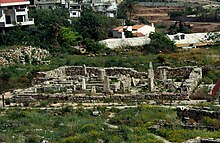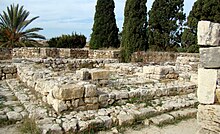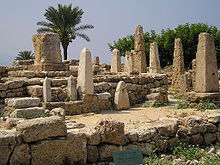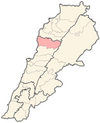Temple of the Obelisks
 Temple of the Obeliques, Lebanon. | |
| Location | Byblos |
|---|---|
| Coordinates | 34°07′08″N 35°38′50″E / 34.11889°N 35.64722°E |
| Site notes | |
| Excavation dates | 1922 |
The Temple of the Obelisks (French: Temple aux Obelisques, Arabic: معبد الأنصاب maebad al'ansab), also known as the L-shaped Temple and Temple of Resheph[1] was an important Bronze Age temple structure in the World Heritage Site of Byblos.[2] It is considered "perhaps the most spectacular" of the ancient structures of Byblos.[3] It is the best preserved building in the Byblos archaeological site.[4]
Almost all of the artefacts found in the excavation of the temple are displayed at the National Museum of Beirut.[3] It was excavated by French archaeologist Maurice Dunand from 1924-73. The original temple is now in two parts: the base is known as "the L-shaped temple", and the top is known as the "Temple of the Obelisks"; the latter was moved 40 meters east during Maurice Dunand's excavations.[2]
Dunand uncovered 1306 Byblos figurines – ex-voto offerings, including faience figurines, weapons, and dozens of bronze-with-gold-leaf figurines – which have become the "poster child" of the Lebanese Tourism Ministry.[5]
Description
[edit]Base: L Shaped Temple
[edit]
The L-shaped Temple was constructed around 2600 BCE,[6] two centuries after the construction of the Temple of Baalat Gebal (approximately 100m to the west) had been built.[6] It was named the "L-shaped" temple by Dunand, as its two rooms and the courtyard were arranged in such a shape.[6]
The temple had well built walls and temples, in contrast to the later Obelisk temple.[2] It is thought that the L-shaped temple was burned down at the end of the Early Bronze Age.[7]
Top: Obelisk Temple
[edit]
The Temple of the Obelisks was constructed around 1600 BCE [citation needed] on top of the L-shaped temple, retaining its general outline.[2] The temple's name, given by Dunand, refers to a number of obelisks and standing stones located in a court around the cella.[7] The Abishemu Obelisk has been interpreted to include a dedication to Resheph, a Canaanite war god, although this is disputed.[7] Another obelisk has a hieroglyphic inscription Middle Bronze Age king of Byblos Ibishemu, praising the Egyptian god Heryshaft. [8]
Since it had been built on top of the L-shaped temple, it was necessary for Dunand to dismantle and move this upper temple in order to excavate the l-shaped temple beneath.[2]
In contrast to the l-shaped temple beneath, the Obelisk temple was built with irregular walls.[9]
Modern identification and excavation
[edit]The temple was first identified by Dunand.[10][7] The majority of the obelisks found were underground in their original positions, standing upright, while a few others were discovered buried in a favissa (a well for votive deposits).[7]
-
1959 view of the temple base and top
-
Montet's 1924 diagram of the Byblos archaeological site
-
Montet's 1924 diagram of the Byblos temples
-
The Byblos figurines
-
The Abishemu obelisk
References
[edit]- ^ Kilani 2019, p. 57a...based on a disputed translation of the Abishemu obelisk
- ^ a b c d e Boda 1994, p. 146.
- ^ a b Michaelides 2001, p. 21.
- ^ Kilani 2019, p. 57.
- ^ Steiner, Margreet L.; Killebrew, Ann E. (2014). The Oxford Handbook of the Archaeology of the Levant: C. 8000-332 BCE. OUP Oxford. pp. 465–. ISBN 978-0-19-921297-2.
- ^ a b c Bryce 2009, p. 138.
- ^ a b c d e Kilani 2019, p. 57-58.
- ^ Kilani 2019, p. 57-59.
- ^ Boda 1996, p. 147.
- ^ Dunand 1937.
Sources
[edit]- Boda, Sharon La (1994). International Dictionary of Historic Places: Middle East and Africa. Taylor & Francis. ISBN 978-1-884964-03-9.
- Bryce, Trevor (10 September 2009). The Routledge Handbook of the Peoples and Places of Ancient Western Asia: The Near East from the Early Bronze Age to the Fall of the Persian Empire. Routledge. ISBN 978-1-134-15908-6.
- Kilani, Marwan (24 October 2019). Byblos in the Late Bronze Age: Interactions Between the Levantine and Egyptian Worlds. Brill. ISBN 978-90-04-41659-8.
- Michaelides, Demetrios (2001), Report on Mission to Byblos (Lebanon), International Council on Monuments and Sites
Archaeological reports
[edit]- Dunand, Maurice (1937). Fouilles de Byblos: Atlas : 1926-1932. P. Geuthner.
Further reading
[edit]- Finkbeiner, Uwe [in German] (1981). Untersuchungen zur Stratigraphie des Obeliskentempels in Byblos: Versuch einer methodischen Auswertung. G. Mann.
- Miniaci, Gianluca. Deposit f (Nos. 15121–15567) in the Obelisk Temple at Byblos: Artefact Mobility in the Middle Bronze Age I–II (1850–1650 BC) between Egypt and the Levant, Aegypten und Levante 28, 379-408.
- Sala, Maura (2008). "Temple En L A Biblo" (PDF). Vicino Oriente. Vol. XIV. pp. 61–87.
External links
[edit] Media related to Temple of the Obelisks at Wikimedia Commons
Media related to Temple of the Obelisks at Wikimedia Commons







